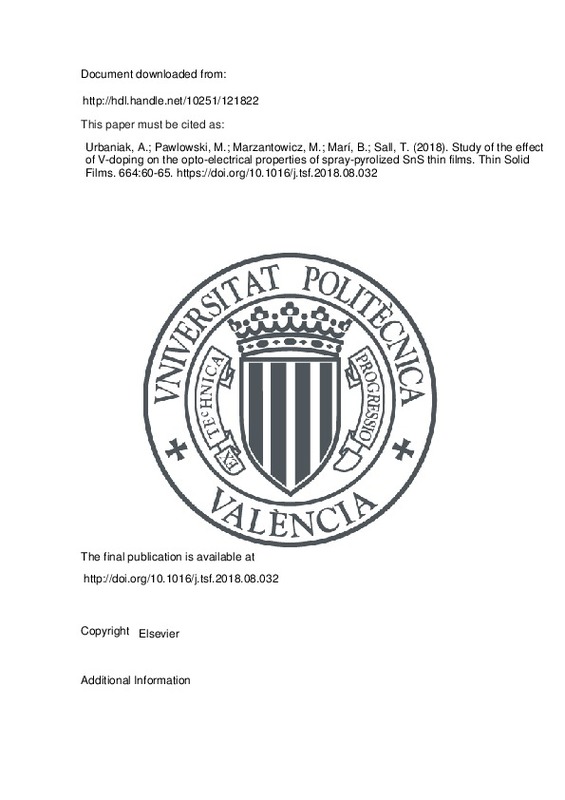JavaScript is disabled for your browser. Some features of this site may not work without it.
Buscar en RiuNet
Listar
Mi cuenta
Estadísticas
Ayuda RiuNet
Admin. UPV
Study of the effect of V-doping on the opto-electrical properties of spray-pyrolized SnS thin films
Mostrar el registro sencillo del ítem
Ficheros en el ítem
| dc.contributor.author | Urbaniak, A.
|
es_ES |
| dc.contributor.author | Pawlowski, M.
|
es_ES |
| dc.contributor.author | Marzantowicz, M.
|
es_ES |
| dc.contributor.author | Marí, B.
|
es_ES |
| dc.contributor.author | Sall, Thierno
|
es_ES |
| dc.date.accessioned | 2019-06-08T20:02:36Z | |
| dc.date.available | 2019-06-08T20:02:36Z | |
| dc.date.issued | 2018 | es_ES |
| dc.identifier.issn | 0040-6090 | es_ES |
| dc.identifier.uri | http://hdl.handle.net/10251/121822 | |
| dc.description.abstract | [EN] SnS is an earth-abundant material that is a potentially suitable candidate for the absorber layer in solar cells. Here spray-pyrolized SnS thin films doped with vanadium were studied using structural and opto-electrical methods. The thin films have an orthorhombic structure with a preferential (111) crystallographic direction. SnS has an indirect bandgap of around 1.05 eV, whereas doping with vanadium changes the band edge and shifts the absorption threshold to around 1.2 eV. The photoluminescence study revealed a broad peak related to the band-to-band transition of energy at around 1.2 eV and an additional sharp peak positioned at 1.17 eV related to vanadium. Additionally, a non-radiative recombination mechanism followed by hopping through band fluctuation barriers has been proposed for photoluminescence quenching at increased temperatures. The conductivity measurements reveal that conductivity weakly increases with V-doping, whereas its activation energy decreases from around 0.38 eV to 0.35 eV. | es_ES |
| dc.description.sponsorship | This work was supported by the Minister den Economic y Competitividad (ENE2016-77798-C4-2-R) and Generalitat Valencia (Prometeus 2014/044). | es_ES |
| dc.language | Inglés | es_ES |
| dc.publisher | Elsevier | es_ES |
| dc.relation.ispartof | Thin Solid Films | es_ES |
| dc.rights | Reconocimiento - No comercial - Sin obra derivada (by-nc-nd) | es_ES |
| dc.subject | Tin sulfide | es_ES |
| dc.subject | Thin films | es_ES |
| dc.subject | Photovoltaics | es_ES |
| dc.subject | Spray pyrolysis | es_ES |
| dc.subject | Photoluminescence | es_ES |
| dc.subject.classification | FISICA APLICADA | es_ES |
| dc.title | Study of the effect of V-doping on the opto-electrical properties of spray-pyrolized SnS thin films | es_ES |
| dc.type | Artículo | es_ES |
| dc.identifier.doi | 10.1016/j.tsf.2018.08.032 | es_ES |
| dc.relation.projectID | info:eu-repo/grantAgreement/MINECO//ENE2016-77798-C4-2-R/ES/APROVECHAMIENTO DE LA LUZ SOLAR CON PROCESOS DE DOS FOTONES-TF/ | es_ES |
| dc.relation.projectID | info:eu-repo/grantAgreement/GVA//PROMETEOII%2F2014%2F044/ES/Técnicas de Fabricación Avanzada y Control de Calidad de nuevos materiales multifuncionales en movilidad sostenible/ | es_ES |
| dc.rights.accessRights | Abierto | es_ES |
| dc.contributor.affiliation | Universitat Politècnica de València. Departamento de Física Aplicada - Departament de Física Aplicada | es_ES |
| dc.contributor.affiliation | Universitat Politècnica de València. Instituto de Diseño para la Fabricación y Producción Automatizada - Institut de Disseny per a la Fabricació i Producció Automatitzada | es_ES |
| dc.description.bibliographicCitation | Urbaniak, A.; Pawlowski, M.; Marzantowicz, M.; Marí, B.; Sall, T. (2018). Study of the effect of V-doping on the opto-electrical properties of spray-pyrolized SnS thin films. Thin Solid Films. 664:60-65. https://doi.org/10.1016/j.tsf.2018.08.032 | es_ES |
| dc.description.accrualMethod | S | es_ES |
| dc.relation.publisherversion | http://doi.org/10.1016/j.tsf.2018.08.032 | es_ES |
| dc.description.upvformatpinicio | 60 | es_ES |
| dc.description.upvformatpfin | 65 | es_ES |
| dc.type.version | info:eu-repo/semantics/publishedVersion | es_ES |
| dc.description.volume | 664 | es_ES |
| dc.relation.pasarela | S\386411 | es_ES |
| dc.contributor.funder | Generalitat Valenciana | es_ES |
| dc.contributor.funder | Ministerio de Economía y Competitividad | es_ES |







![[Cerrado]](/themes/UPV/images/candado.png)

